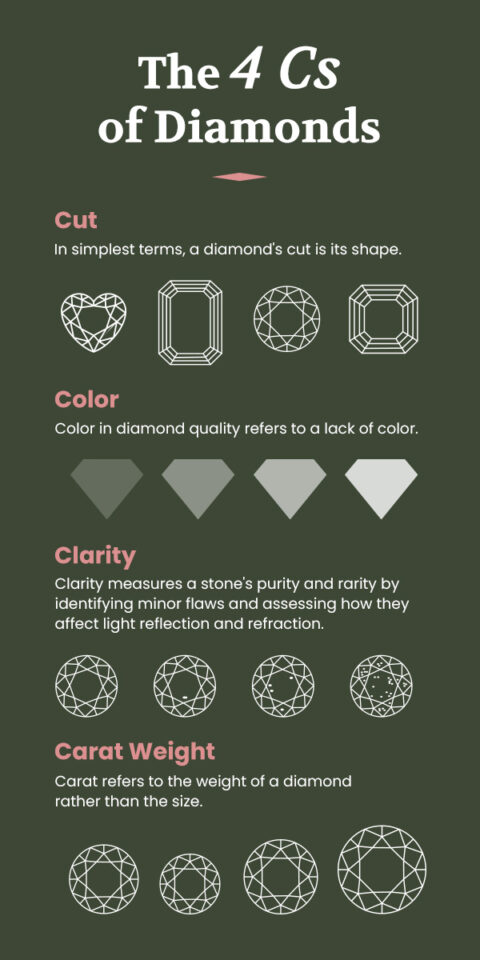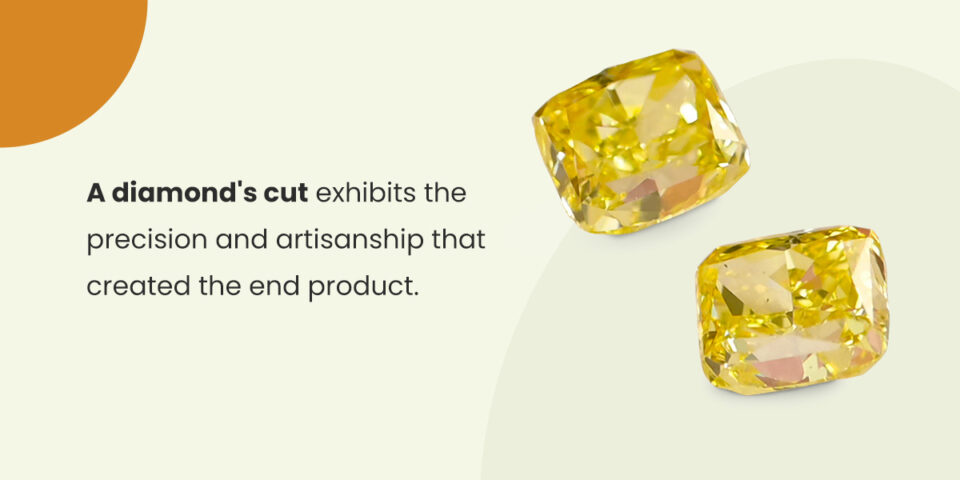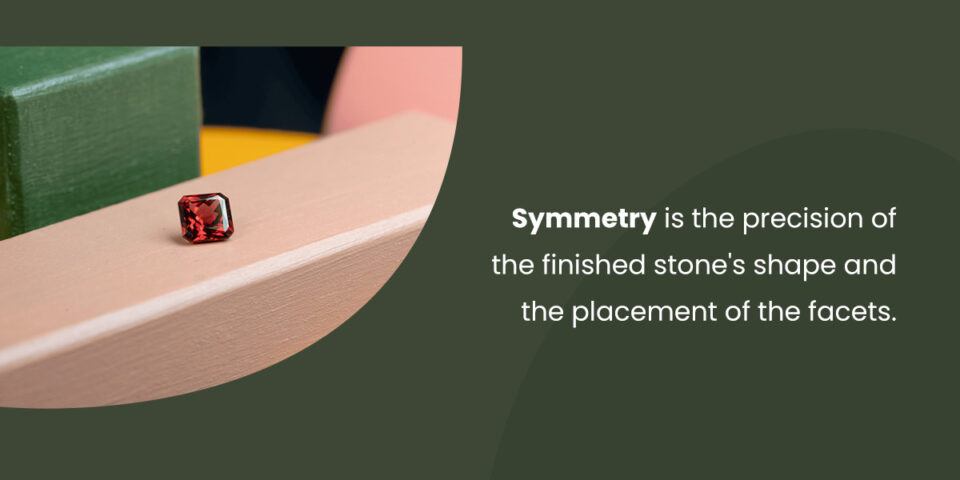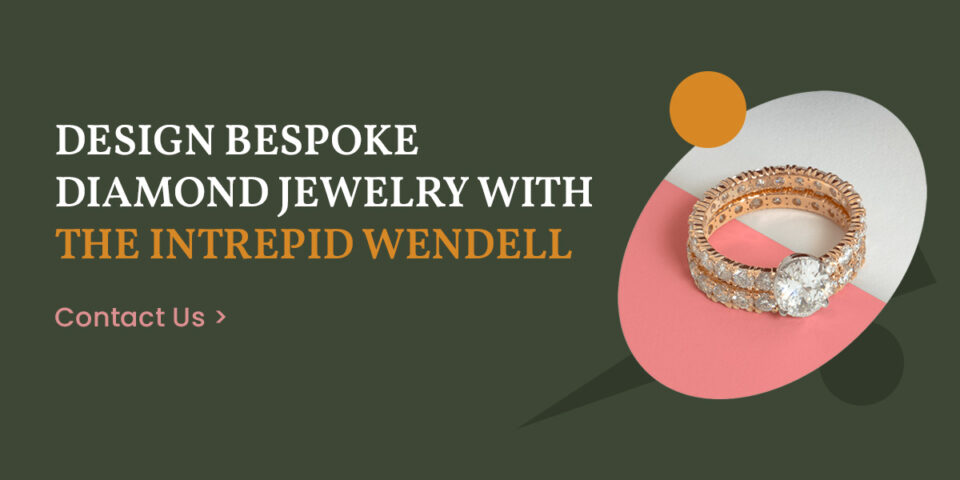The 4 Cs of Diamonds
Diamonds, like snowflakes, have unique characteristics. The right balance of these creates a rare and valuable stone in line with internationally accepted standards. When designing a piece of jewelry, the Four Cs of diamonds can help you find a stone that complements your vision.
You may have heard of the Four Cs. They may have even informed some of your past purchases. However, a simple Four Cs of diamonds chart is often not enough to find the elusive stone you need. These guidelines can help you narrow your focus and find the ideal stone for your next jewelry design. Use them to your advantage so you can find the perfect centerpiece for your next bespoke jewelry design.
What Are the 4 Cs of Diamond Quality?

The Four Cs of diamonds are internationally recognized standards for assessing diamond quality. This system guides traders, jewelers, and buyers through evaluating a faceted diamond. While the different elements of a diamond can be complex, breaking its primary features into specifics can help you find the perfect centerpiece for your jewelry. The Four Cs are cut, color, clarity, and carat weight:
Cut
In simplest terms, a diamond’s cut is its shape. It refers to how the raw diamond was cut and shaped. The cut of a diamond showcases its quality, reflecting light internally from one facet to the next. The more expertise and artistry used to create these precise proportions, the more the diamond captivates the eye. The quality of a cut rests on three main factors:
- Precision: A cut’s precision indicates how the size and angles relate to the overall presentation of the stone.
- Symmetry: Symmetry refers to whether the diamond appears even or lopsided. Most people prefer symmetrical diamonds with facets that align and intersect to create a balanced stone.
- Polish: The polish of a stone refers to the outside finish. A smooth diamond will reflect light better than a stone with scratches or an uneven surface.
A poorly cut diamond will appear dull even with a high color and clarity grade, and a good cut can mask other imperfections in a lower-quality stone. Round brilliant diamonds have one cut grade, classified as poor, fair, good, very good, or excellent. Cut is the process of turning a diamond into something remarkable, reflecting the light and drawing the eye.
Color
Color in diamond quality refers to a lack of color. Colorless diamonds are rare, making them the highest quality, while diamonds with brown or yellow color are the lowest. A diamond grader decides the color grade using a master set of diamonds, expert tools and considerable experience. People grade diamonds, not machines, adding another element to their rarity.
Diamond color is graded on a scale of D to Z, with D, E, and F being colorless, and Z being light brown or yellow. Although colorless diamonds have the highest grading, some people prefer diamonds with a slight yellow color, as they have warmth. Color is a matter of personal preference, but most people look for colorless diamonds.
The reason colorless diamonds are so highly prized is the dynamic way they interact with light. Other natural colors, such as red, yellow, or blue, are known as fancy-colored diamonds. Colorless and fancy-colored diamonds are rare stones, ideal for conceptualizing a one-of-a-kind piece of jewelry unique to your own story.
Clarity
Clarity measures a stone’s purity and rarity by identifying minor flaws and assessing how they affect light reflection and refraction. A diamond grader puts the stone under 10x magnification, and if it has no inclusions or blemishes, it is graded flawless. The number of flaws a diamond has determines its rarity and quality, and flawless diamonds are the most valuable.
A diamond may have inclusions and still appear flawless to the naked eye. These tiny imperfections affect how the stone reflects and refracts light, so clarity is essential when choosing a diamond for a particular piece of jewelry.
Carat Weight
Carat refers to the weight of a diamond rather than the size. A one-carat diamond weighs 0.2 grams. Two diamonds can have the same weight and appear entirely different, so many consider the carat the least important of the Four Cs. However, the larger the carat weight, the more valuable the stone. However, every diamond is unique, and a lower carat may be better suited to a bespoke piece of jewelry due to its size, cut, and clarity.
Why Are the 4 Cs Important When Buying Jewelry?
Buying jewelry is both a financial and emotional investment. Like any investment, information is critical. Your jewelry and diamond choice depends on several factors, including your budget, taste, and the occasion. When buying a diamond, you have a set of priorities, and the Four Cs can guide you as you look for the perfect stone for your jewelry design or concept. Some of the many benefits of using the Four Cs when buying jewelry include:
- Find the perfect size: While carat weight indicates diamond value, finding the right size for your design or concept can be more important for the finished piece. If your concept would benefit from a larger stone, you can create the illusion of size to fit your budget with a suitable shape.
- Elevate the aesthetic: Color can transform the aesthetic of your design, changing how it reflects light, adding warmth, and playing off your surroundings. Understanding diamond color options can help you find a stone that highlights your jewelry design, bringing a warm undertone or an icy sparkle, depending on your preferences.
- Showcase a rare stone: The rarest diamonds are at the top of the scale for each of the Four Cs. Your diamond must do more than merely complement your design — it must inspire something memorable. The Four Cs can help you find and showcase a rare diamond, allowing you to design something unique.
- Enhance your aesthetic: Cut brings out the best in every stone. Focusing on the cut can turn an average diamond into a dazzling centerpiece and an exceptional stone into a one-of-a-kind piece of jewelry.
- Maximize value: The Four Cs help evaluate diamond rarity and value. Knowing these guidelines is essential to buying a quality diamond that reflects your unique preferences. Considering the Four Cs can help you get the best stones for your budget if you want rare and valuable diamonds for your jewelry.
Although the Four Cs can inform your choices and ensure you get the best value, they are just guidelines. Depending on your jewelry design, one C may be more important to your piece, while another becomes irrelevant. A bespoke jewelry item should reflect you, including details that speak to your personality and unique story. A quality stone is an integral part of the process, but there is also an emotional element to consider when selecting a stone.
Which of the 4 Cs Is Most Important?

Choosing a diamond is a unique and personal endeavor, and the most important of the Four Cs is the topic of some debate. A diamond must be beautiful for all its qualities, though its cut affects its appearance significantly, from the number and angle of the facets to how the stone reflects and refracts the light.
A diamond’s cut exhibits the precision and artisanship that created the end product. Cut is the only element of your diamond not influenced by nature. Two diamonds can have the same color, clarity, and carat, but how they are cut can turn one into a masterpiece and the other into an inferior product. Whether wearing a diamond or gifting it to someone to mark a special occasion, the cut takes their breath away.
While the cut is arguably the most important of the Four Cs, the remaining three substantially affect your choice. Consider the following to help you make the perfect choice for your next bespoke jewelry item:
- Color: Whether you prefer the icy sparkle of a colorless diamond or the welcoming warmth that accompanies a hint of yellow, look at your diamond under natural light to get the best sense of whether it works with your design. Color variations are also subtle, and once your stone is mounted, you may not be able to see a difference with the naked eye. You may opt instead for a rarer stone, allowing the surroundings to influence its colorless appearance.
- Clarity: As many flaws are invisible to the naked eye, you could purchase a less expensive stone without any noticeable difference. While no one wants a flawed stone, you can strike a happy medium, depending on how you plan to mount it. If you want a truly rare diamond, investing in a flawless rating could be an excellent next chapter in your story.
- Carat: Aside from indicating rarity and quality, a diamond’s weight can influence your choice. A heavier diamond may be better suited to your jewelry concept. The heavier a diamond, the rarer and more valuable it is. Carat plays a more significant role when you want a piece that speaks of luxury and rarity.
When you design a piece of jewelry, your choices are deeply personal, and a diamond is the jewel in the crown. Each of the Four Cs is essential to find the perfect stone to tell your story. However, your choice depends on your experiences, concepts, and preferences. With the Four Cs as a guideline, you can find the perfect diamond to bring your idea to life.
Understanding Diamond Cut
Cut is the most precise and complex characteristic of the Four Cs. While cut generally refers to a diamond’s shape, the details are more nuanced. Cutting a diamond influences how the stone interacts with light, enhancing its innate beauty and value. The Gemological Institute of America (GIA) calculated the proportions of a diamond’s facets to determine the grade of a standard brilliant diamond. These proportions allow gemologists to determine the best cut for a diamond by testing how it interacts with light.
A diamond’s cut enhances its natural ability to interact with light and create the following visual effects:
- Fire: Fire refers to how a diamond scatters and refracts white light to reveal the entire spectrum of colors.
- Scintillation: Reflections within a diamond cause a pattern of light and dark areas, producing a sparkle. Scintillation is how much sparkle a specific diamond produces.
- Brightness: Brightness refers to how much internal and external white light a diamond reflects.
Cutting a diamond involves choosing and executing the ideal facets and proportions to highlight the stone’s innate ability to manipulate light. Gem cutters must consider several elements to achieve the ultimate overall picture, including:
Artistry and Quality

A symmetrical diamond has expertly aligned facets, reflecting and refracting light to display maximum sparkle. As intricate as the cut might be, every facet of a stone is polished after the cutting process. The care the gem cutter puts into each stone is visible in the polish and symmetry of the end product.
Symmetry is the precision of the finished stone’s shape and the placement of the facets. A symmetrical diamond has a balanced brightness, fire, and scintillation, while poor symmetry causes the stone to appear flat and dull.
GIA Cut Grade Chart
A diamond’s cut relies entirely on human expertise, so a professional GIA gemologist reviews each stone under magnification to determine the cut grade. The GIA cut grades for round diamonds are:
- Excellent: The vast majority of incoming light is reflected through the table, giving the diamond the highest level of fire and brilliance.
- Very good: Most incoming light reflects through the table for exceptional fire and brilliance. To the naked eye, a very good cut is almost identical to an excellent one.
- Good: A good diamond cut still provides brilliance and sparkle, with most of the light reflecting through the table. Good cuts are superb for sparkle and brilliance on a lower budget.
- Fair: Light easily escapes through the bottom and sides of the stone, making fair cuts best suited to smaller diamonds and side stones.
- Poor: As most light escapes through the sides and bottom, these diamonds provide almost no sparkle, fire, or brilliance.
Depth
A diamond’s depth is measured from its table, or top, to its culet, or bottom. Its depth percentage measures its depth in relation to its total width. An ideal depth percentage elevates the quality of its cut and the amount of light it reflects. Light escapes a shallow-cut diamond from its sides instead of reflecting from the table. A diamond cut too deep will appear smaller than its carat weight.
With the proper depth, balance, and angle, the diamond will appear luminous as light travels to its center, bounces off the internal walls, and disperses into multiple colors.
Design Bespoke Diamond Jewelry With The Intrepid Wendell
Although favored for engagement and wedding rings, diamonds are a classic, elegant, and eye-catching choice for any piece of jewelry. Whether you set them in tennis bracelets, pendant necklaces, decadent earrings, or any other piece, their brilliance and sparkle will turn heads.
The passionate designers at The Intrepid Wendell work with you to bring your ideas to life. With a blend of our expertise, access to the rarest gems in the world, and your imagination, our in-house GIA-certified gemologist can find the highest quality stone to tell your story. We can create exquisite bespoke pieces with the rarest and highest-grade stones, breathing life into your vision at every stage of the design process. Contact us to learn more and add a unique piece to your collection today.

